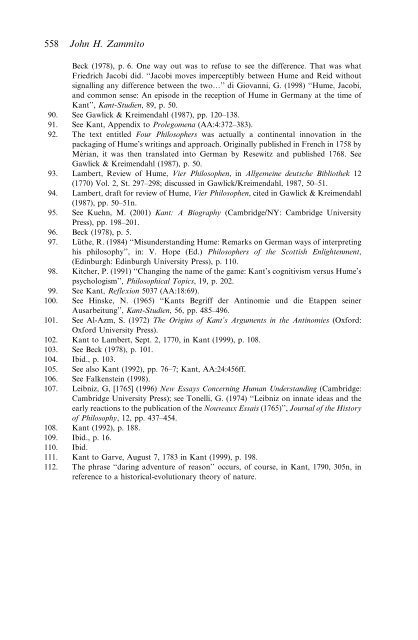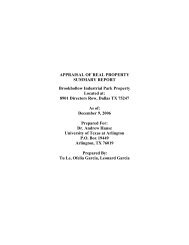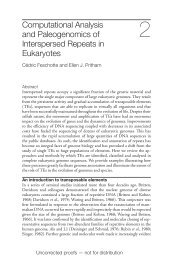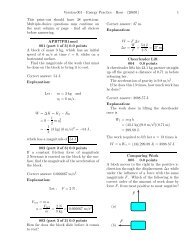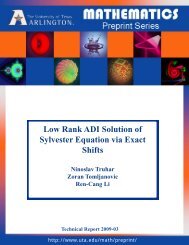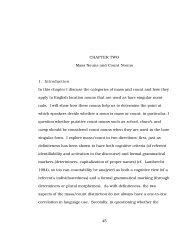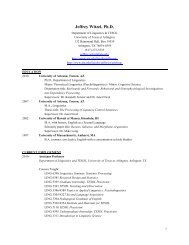<strong>Kant</strong> <strong>and</strong> <strong>Naturalism</strong> <strong>Reconsidered</strong> 557mathematics <strong>and</strong> general science of nature; <strong>and</strong> this fact therefore suffices todisprove such derivation (B127–8).Of course, we need not simply accept <strong>Kant</strong>’s verdict. Lewis White Beck felt driven toacknowledge that ‘‘Hume’s implicit account of the causal principle is much more like<strong>Kant</strong>’s own than <strong>Kant</strong> had any reason to suspect.’’ Beck, L. W. (1978) Essays on <strong>Kant</strong><strong>and</strong> Hume (New Haven: Yale University Press), p. 120. And Falkenstein has offered anextensive development of this view (1998) ‘‘Hume’s answer to <strong>Kant</strong>’’, Nous, 32,pp. 331–360. See also two recent essays which assess the complexity of the questionwithout simply presuming <strong>Kant</strong>’s position: Langsam, H. (1994) ‘‘<strong>Kant</strong>, Hume, <strong>and</strong> ourordinary concept of causation’’, Philosophy <strong>and</strong> Phenomenological Research, 54,pp. 625–647, <strong>and</strong> Nuyen, A. T. (1990) ‘‘Sense, reason <strong>and</strong> causality in <strong>Kant</strong> <strong>and</strong>Hume’’, <strong>Kant</strong>-Studien, 81, pp. 57–68.74. Thus, <strong>Kant</strong> comes to the rescue of his queen with the same gallantry that Burke evokedin his longing to have rescued Marie Antoinette in Burke, E. [1790] (2001) Reflectionson the Revolution in France (Stanford: Stanford University Press).75. See Beck (1978), pp. 3–19.76. See Bird (1995), p. 401n.77. <strong>Kant</strong> (1992), p. 6. <strong>Kant</strong> indifferently used Verst<strong>and</strong> <strong>and</strong> Vernunft in connection withGesundheit. The translators generally use ‘‘healthy reason’’ so I will comply, though Iprefer healthy underst<strong>and</strong>ing, or, better still, ‘‘common sense,’’ which captures theessential colloquial connotation.78. Ibid., p. 6.79. <strong>Kant</strong> (1992), p. 12. Indeed, ‘‘there really <strong>and</strong> properly is no science of the beautiful[schöne Wissenschaft] at all; rather what we know of the beautiful is nothing but acritica.’’ Ibid.80. Ibid., p. 6.81. Ibid., p. 12.82. Ibid., p. 13.83. Ibid., p. 8.84. From Logic Philippi.85. For some classical contributions to the underst<strong>and</strong>ing of <strong>Kant</strong>’s transcendentalargumentation, see Korner, S. (1967), Stroud, B. (1969) ‘‘Transcendental arguments’’,in: T. Penelhum & J. J. MacIntosh (Eds.), The First Critique: Reflections on <strong>Kant</strong>’sCritique of Pure Reason, pp. 54–69 (Belmont, CA: Wadsworth), Henrich, D. (1969)‘‘The proof structure of <strong>Kant</strong>’s transcendental deduction’’, Review of Metaphysics, 22,pp. 640–59, Hintikka, J. (1972) ‘‘Transcendental arguments: Genuine <strong>and</strong> spurious’’,Nous, 6, pp. 274–81, Schaper, E. (1972) ‘‘Arguing transcendentally’’, <strong>Kant</strong>-Studien, 63,pp. 101–16, Ameriks, K. (1978) ‘‘<strong>Kant</strong>’s transcendental deduction as a regressiveargument’’, <strong>Kant</strong>-Studien, 69, pp. 272–87. Up through the present, every few months,some new effort to make sense of transcendental arguments appears in the journalliterature.86. See Locke, Essay Concerning Human Underst<strong>and</strong>ing <strong>and</strong> Buickerood, J. (1985) ‘‘Thenatural history of the underst<strong>and</strong>ing: Locke <strong>and</strong> the rise of facultative logic in theeighteenth century’’, History <strong>and</strong> Philosophy of Logic, 6, pp. 157–190.87. See Zammito (2002), pp. 179–220.88. See Kuehn, M. (1983) ‘‘The early reception of Reid, Oswald <strong>and</strong> Beattie in Germany’’,Journal of the History of Philosophy, 21, pp. 479–485, (1987) Scottish Common Sense inGermany (Kingston, Ontario: McGill/Queens University Press).89. Beck, indeed, sees this as a good way to describe <strong>Kant</strong>’s critical problem: ‘‘How couldhe oppose Hume without falling in with Reid, Beattie, <strong>and</strong> Oswald… How could hegive up a supernatural metaphysics without making a metaphysics of naturalism?’’
558 John H. ZammitoBeck (1978), p. 6. One way out was to refuse to see the difference. That was whatFriedrich Jacobi did. ‘‘Jacobi moves imperceptibly between Hume <strong>and</strong> Reid withoutsignalling any difference between the two…’’ di Giovanni, G. (1998) ‘‘Hume, Jacobi,<strong>and</strong> common sense: An episode in the reception of Hume in Germany at the time of<strong>Kant</strong>’’, <strong>Kant</strong>-Studien, 89, p. 50.90. See Gawlick & Kreimendahl (1987), pp. 120–138.91. See <strong>Kant</strong>, Appendix to Prolegomena (AA:4:372–383).92. The text entitled Four Philosophers was actually a continental innovation in thepackaging of Hume’s writings <strong>and</strong> approach. Originally published in French in 1758 byMérian, it was then translated into German by Resewitz <strong>and</strong> published 1768. SeeGawlick & Kreimendahl (1987), p. 50.93. Lambert, Review of Hume, Vier Philosophen, inAllgemeine deutsche Bibliothek 12(1770) Vol. 2, St. 297–298; discussed in Gawlick/Kreimendahl, 1987, 50–51.94. Lambert, draft for review of Hume, Vier Philosophen, cited in Gawlick & Kreimendahl(1987), pp. 50–51n.95. See Kuehn, M. (2001) <strong>Kant</strong>: A Biography (Cambridge/NY: Cambridge UniversityPress), pp. 198–201.96. Beck (1978), p. 5.97. Lüthe, R. (1984) ‘‘Misunderst<strong>and</strong>ing Hume: Remarks on German ways of interpretinghis philosophy’’, in: V. Hope (Ed.) Philosophers of the Scottish Enlightenment,(Edinburgh: Edinburgh University Press), p. 110.98. Kitcher, P. (1991) ‘‘Changing the name of the game: <strong>Kant</strong>’s cognitivism versus Hume’spsychologism’’, Philosophical Topics, 19, p. 202.99. See <strong>Kant</strong>, Reflexion 5037 (AA:18:69).100. See Hinske, N. (1965) ‘‘<strong>Kant</strong>s Begriff der Antinomie und die Etappen seinerAusarbeitung’’, <strong>Kant</strong>-Studien, 56, pp. 485–496.101. See Al-Azm, S. (1972) The Origins of <strong>Kant</strong>’s Arguments in the Antinomies (Oxford:Oxford University Press).102. <strong>Kant</strong> to Lambert, Sept. 2, 1770, in <strong>Kant</strong> (1999), p. 108.103. See Beck (1978), p. 101.104. Ibid., p. 103.105. See also <strong>Kant</strong> (1992), pp. 76–7; <strong>Kant</strong>, AA:24:456ff.106. See Falkenstein (1998).107. Leibniz, G, [1765] (1996) New Essays Concerning Human Underst<strong>and</strong>ing (Cambridge:Cambridge University Press); see Tonelli, G. (1974) ‘‘Leibniz on innate ideas <strong>and</strong> theearly reactions to the publication of the Nouveaux Essais (1765)’’, Journal of the Historyof Philosophy, 12, pp. 437–454.108. <strong>Kant</strong> (1992), p. 188.109. Ibid., p. 16.110. Ibid.111. <strong>Kant</strong> to Garve, August 7, 1783 in <strong>Kant</strong> (1999), p. 198.112. The phrase ‘‘daring adventure of reason’’ occurs, of course, in <strong>Kant</strong>, 1790, 305n, inreference to a historical-evolutionary theory of nature.


